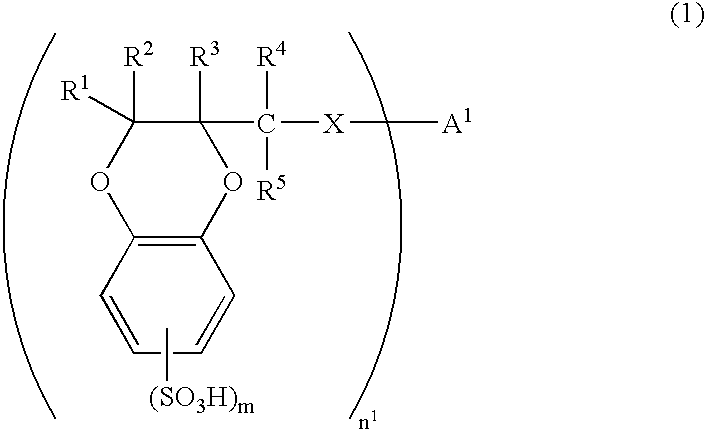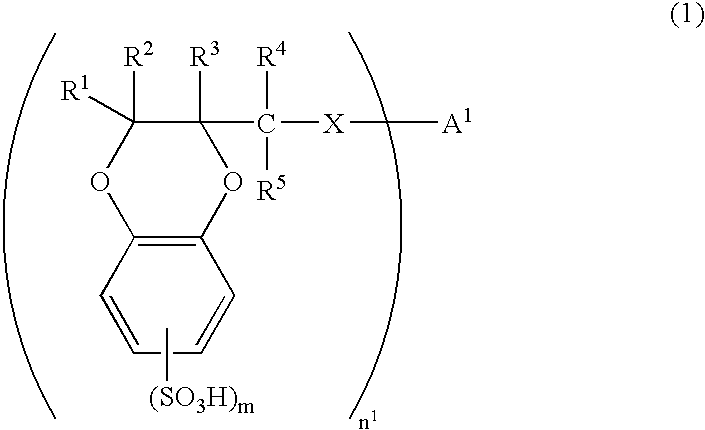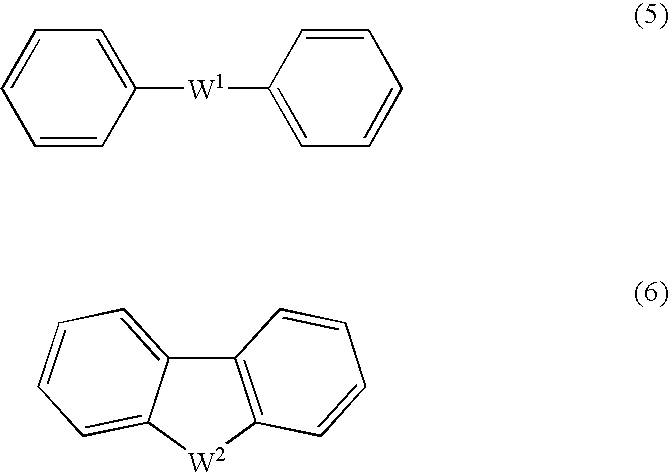1, 4-Benzodioxane sulfonic acid compound and use thereof as electron-acceptor material
- Summary
- Abstract
- Description
- Claims
- Application Information
AI Technical Summary
Benefits of technology
Problems solved by technology
Method used
Image
Examples
example 1
[0160] There was synthesized 2-hydroxymethyl-1,4-benzodioxanedisulfonic acid (HMBDDS for short hereinafter) according to the following reaction formula (17).
[0161] In a reaction vessel was placed 25.40 g of Tiron(4,5-dihydroxy-1,3-benzenedisulfonic acid disodium salt monohydrate, from Kanto Chemical Co., Inc.). To the reaction vessel was sequentially added 9.723 g of anhydrous sodium carbonate and 508 ml of pure water. The reactants were dissolved by stirring at room temperature for 10 minutes. To the reaction vessel was added 7.19 ml of epichlorohydrin. The reactants were stirred at room temperature for 2 hours and then at 70° C. for 13 hours. The reaction solution was allowed to cool to room temperature and then concentrated to dryness under reduced pressure. The residues were crushed with 630 ml of methanol and remaining solids were filtered off and washed with methanol. Washings were added to the filtrate. The filtrate was concentrated to dryness under reduced pressure. The re...
example 2
[0165] There was synthesized an oligomer 1 of 1,4-benzodioxane compound represented by formula (18) and then there was synthesized an oligomer 1 of 1,4-benzodioxanesulfonic acid compound represented by formula (19) in the following manner. The two oligomers are abbreviated as BDO-1 and BDSO-1, respectively, hereinafter.
[0166] In a reaction vessel was placed 15.07 g of 2-hydroxymethyl-1,4-benzodioxane. To the reaction vessel was added 300 ml of dehydrated DMF for dissolution under an atmosphere of nitrogen. To the reaction vessel was further added 4.276 g of 60% sodium hydride. The reactants were stirred at room temperature for 70 minutes and then at 40° C. for 70 minutes under an atmosphere of nitrogen. The reaction solution was allowed to cool to room temperature. To the reaction solution was added 9.974 g of p-xylenedibromide and then stirred at room temperature for 18 hours under an atmosphere of nitrogen. The reaction was suspended by adding 70 ml of saturated aqueous solution...
example 3
[0169] There was synthesized an oligomer 2 of 1,4-benzodioxanesulfonic acid compound according to the reaction formula (20) below. The oligomer is abbreviated as BDSO-2 hereinafter.
[0170] To 2.003 g of the HMBDDS disodium salt (which had been synthesized by the method mentioned in Example 1) were sequentially added under an atmosphere of nitrogen 688 mg of bis (4-fluorophenyl) sulfone, 351 mg of 60% sodium hydride, and 100 ml of anhydrous N,N-dimethylimidazolidinone. The reactants were stirred at 90° C. for 63 hours, with the atmosphere in the reaction system replaced by nitrogen. The reaction solution was allowed to cool to room temperature. The reaction was suspended by adding water, and the reaction solution was concentrated to dryness under reduced pressure. To the residues were sequentially added 50 ml of pure water and about 10 g of cation exchange resin Dowex 650C (H-type). After filtration, the filtrate was concentrated to dryness under reduced pressure. To the residue was...
PUM
| Property | Measurement | Unit |
|---|---|---|
| Length | aaaaa | aaaaa |
| Electric charge | aaaaa | aaaaa |
Abstract
Description
Claims
Application Information
 Login to View More
Login to View More - Generate Ideas
- Intellectual Property
- Life Sciences
- Materials
- Tech Scout
- Unparalleled Data Quality
- Higher Quality Content
- 60% Fewer Hallucinations
Browse by: Latest US Patents, China's latest patents, Technical Efficacy Thesaurus, Application Domain, Technology Topic, Popular Technical Reports.
© 2025 PatSnap. All rights reserved.Legal|Privacy policy|Modern Slavery Act Transparency Statement|Sitemap|About US| Contact US: help@patsnap.com



